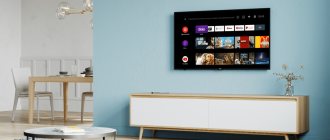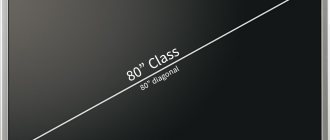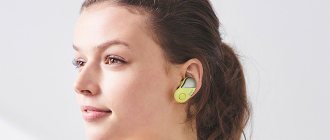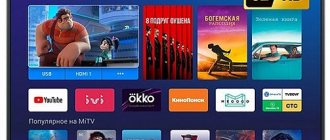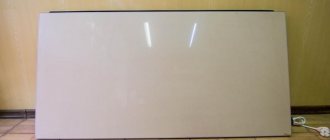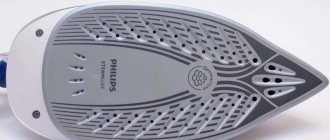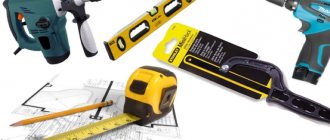In 2013, leading manufacturers of household appliances introduced customers to a curved TV with a concave display shape for a more comfortable viewing of TV shows and movies. In 2014-2015, experiments with screen geometry were carried out by the majority of TV equipment manufacturing companies, since about 52% of buyers were interested in new products on the market. But by mid-2021, demand for them had dropped significantly. This phenomenon is partly due to consumers’ misunderstanding of the technology, incorrect choice of TV models, and their operation. But still, screens of unusual geometry are still being purchased. Therefore, it makes sense to find out what advantages and disadvantages have been found in concave monitors (identified over the years of their operation). Are they worth buying?
Content:
- 1 A little history
- 2 Technical features
- 3 Additional but important characteristics
- 4 Advantages and disadvantages 4.1 Disadvantages of the concave technique
- 4.2 Less noticeable flaws
- 5.1 Samsung UE48 H8000
With the advent of the new image format - 4K, TV manufacturers are developing new solutions to meet the needs of customers. One of the new products is slightly concave models with an interesting design. Let's figure out whether TVs with curved screens really have increased technical characteristics. Is it worth purchasing them for your home or is it better to choose the classic version with the usual direct monitor?
Advantages and disadvantages
At first glance, such a move could well be considered an attempt to pay tribute to style, but such displays have a number of significant advantages. The curved screen creates an optical illusion that causes neurons to move and a person's peripheral vision to turn on. As a result, the image is perceived more realistically, and additional sound effects and excellent color rendition help you fully enjoy your favorite films, TV series and programs.
pros
- Greater viewing angle. This argument is controversial, but is often used to describe the benefits of such televisions. The screen is curved, so it offers a greater level of immersion (view) to the viewer, and the high resolution helps a person to be better immersed in the plot. This parameter only works with TVs that have a large diagonal (from 60 and above).
- Image depth. Such screens significantly increase the depth of the picture and enhance the viewing experience.
- Excellent contrast. The parameter increases. Mostly similar models have 4K resolution (top lines from LG and Samsung)
- Nice appearance.
Minuses
- High cost. It has long been no secret that curved TVs are a little more expensive than their flat friends; this point does not automatically make them attractive in the eyes of users.
- Not suitable for group viewing. That’s why a curved TV is called curved; its “roundness” can slightly interfere with a good view. Especially for those viewers who were unlucky enough to sit a little to the left and to the right, the impression of the film would accordingly deteriorate.
A little history
The first curved TV appeared in 2013. The purpose of creation is to copy the effect that is used in IMAX cinemas. Thanks to the shape of the screen, the contrast and depth of the image increases, which affects the quality of perception and the pleasure of watching movies, especially in 4K format.
Modern TVs with a concave display are immediately equipped with the ability to watch video in 3D, connect Smart TV, perceive 4K resolution and support HDR technology. Manufacturers immediately equip the equipment with all the latest developments. But this also affects the cost of the equipment. A curved screen will cost more than a flat LCD or plasma TV.
Among the main manufacturers of new products are the brands Samsung, LG, Sony, and Philips.
Immersive viewing
Curved TVs provide the most immersive viewing experience. This advantage is determined by the design of the device. This is why cinemas also install screens of this shape. The image looks as natural and realistic as possible. This effect can be achieved due to the fact that the screen bends. The image “comes out” a little forward, literally flowing around the viewer. Although regular TVs are not much inferior to curved models in this regard.
The first reaction of viewers who watched the film on a curved TV was delight. They think they saw a three-dimensional image without 3D glasses. Although in fact this is an ordinary picture in 2D format. This effect occurs because the curved edges increase the visual perception of depth. Samsung enhances this effect by automatically adjusting the contrast of different parts of the picture.
Samsung QE75Q8С
Technical features
All curved screen TVs are thicker than conventional models. When mounting them on the wall, the design features will become disadvantages rather than advantages. They are designed exclusively for installation on special cabinets.
The main characteristics include:
- Brightness. The parameter is not inferior to the best TV with a flat monitor. The indicator can be adjusted. But when watching television with a large group, those viewers who find themselves on the sides and see the curved edges of the TV will receive a lower-quality image than those who are located in the center.
- Resolution or ratio of pixels (matrix elements) to vertical and horizontal area. The higher it is, the better the image quality. Concave TVs with a diagonal of 70 inches or more have a resolution of 3848x2160 pixels, which allows them to support 4K or Ultra HD formats.
- Contrast is a measure of brightness. It can be dynamic or static. The concavity reduces contrast at the edges of the monitor, making it uncomfortable to watch movies up close or from the side.
- Viewing angle affects viewing distance without image distortion. The semicircular TV has an increased viewing angle.
All concave TVs have better image depth. This enhances the immersive experience of 3D movies. At the same time, the optimal viewing angle for new products is 175-178 ⁰ vertically and horizontally.
Important. All the effects of a concave TV are good for watching action movies or dynamic games through special consoles. When watching news or informational TV programs, portrait proportions will be slightly distorted.
Reflection and viewing angle
A curved TV will reduce contrast on the sides of the screen. Provided that the viewer is located as close as possible to the source of viewing. Modern video file formats will smooth out the contrast on the sides.
Samsung UE49KS7500U
There are very few comfortable viewing points, so watching TV in a large group will be very uncomfortable. However, this drawback is typical for both straight and concave screens. There are no significant differences between these TVs. The declared advantages of curved TV manufacturers are visible only on paper.
Optical distortion is another important point. The sensor sensors of the matrix, which provide focusing, are located throughout the plane. Therefore, video files are initially designed to be viewed on a flat surface. When a curved surface is involved, the picture may become distorted. This criterion once again confirms that ordinary flat TVs are in no way inferior to curved ones.
During viewing, the sun's rays fall on the screen. The curvature of the plane is a catalyst for changing the angle of refraction of rays, so the amount of glare is reduced. This effect is especially noticeable in rooms with bright lighting. The further the user is from the screen, the more the intensity of the glow of foreign objects on the screen will decrease.
Samsung SUHD UE65JS9000TXRU
Additional but important features
When choosing any TV, it is important to look not only at the general contrast and resolution characteristics, but also at the following points:
- Response time or rate of change of pixel state. The clearest image is obtained with a fast response time. TVs with OLED technology have the best performance. Among semicircular models, it is also better to pay attention to options with OLED.
- Valid connection interfaces. Modern TVs most often provide USB and HDMI connectors. They are convenient for connecting flash drives, mobile devices, receivers, and set-top boxes. The Smart TV function allows you to connect the Internet directly to your equipment and thereby expand the capabilities of the TV.
- Screen diagonal is measured in inches (1 inch = 2.54 cm). Select a parameter depending on the planned viewing range. In ideal proportions, the distance of the sofa should be equal to 3-4 screen diagonals. The optimal indicator is considered to be from 70 inches. Full immersion into the world of 3D cinema is provided by models with a diagonal of 100 inches.
Important! It's not just the TV that affects picture quality. If digital television is carried out via an antenna cable with a bandwidth up to HD quality (1280x720), then even with the most powerful TV you cannot get Ultra HD resolution.
Best 65" Curved TV
The best color reproduction and sound are guaranteed by a large 65-inch screen. The models are characterized by a presentable appearance, so they are installed in living rooms, country houses, and cafes. This rating category included curved smart TVs with the best technical characteristics and modern technologies.
Samsung UE65RU7300U
The slim, stylish case impresses with its size and functionality. The Smart TV class is powered by a 4-core Tizen processor. Connection to the Internet is made via Wi-Fi or Ethernet. Edge LED technology produces images with a resolution of 3840×2160 in UltraHD quality. Digital Clean View technology ensures the accuracy of the digital signal without distortion. Built-in speakers produce 20W surround sound. The installed tuners reproduce satellite and cable channels, and there is a connector for a satellite dish. The monitor can be used in gaming mode by connecting a keyboard and mouse. Diagonal 65, which is equivalent to 163 cm. Supported media – USB, connectors – HDMI 2.0, audio/video inputs, slot for CI/PCMCIA, Bluetooth, Ethernet. Additional options – TimeShift, recording, DLNA, remote control, eco sensor. Weight 25 kg.
Advantages
- Modern appearance;
- Fast Internet;
- Smart TV;
- Color rendition, picture detail;
- Digital signal accuracy;
- Wide functionality.
Flaws
- Regular remote control, no voice control;
- Weak sound.
With such dimensions (larger than the parent version) and capabilities, this is a worthy offer from the brand (the price is one and a half times lower).
Here you can not only watch movies, TV, but also connect a set-top box, computer, external sources of information, and the Internet. Wall mounting VESA 400x400, side legs on the cabinet.
QLED Samsung QE65Q8CNA
The review is completed by an LCD panel with a 65-inch (163 cm) QLED screen and LED edge backlighting. Picture resolution 3840×2160 pixels, HDR10+ quality with increased clarity, detail elaboration. The sound is also cinematic quality - surround, realistic due to Dolby Digital Plus technology with a power of 40 W. The introduction of Q Contrast technology ensures detail even in dark tones of the image. Tizen operating system supports Smart TV with voice commands. Connectors – USB, HDMI 2.0, antenna inputs, audio/video outputs, slot for CI/PCMCIA, Ethernet (RJ-45), Bluetooth, built-in Wi-Fi. Additional options – technology for connecting to a PC, DLNA smartphones, remote control, TimeShift, video recording. Using the TV you can control other home appliances. Weight 24 kg.
Advantages
- High contrast;
- Several HDR modes;
- Ambient mode;
- Good acoustics;
- Record, pause viewing;
- Voice control.
Flaws
- There is no headphone output;
- Flickering at low brightness.
The main difference between this device and the previous ones is the Ambient mode, an information screen in the form of a gallery with statistical images, for example, weather, news, etc. This is one of the most advanced models with a built-in multimedia player and advanced functionality.
Advantages and disadvantages
A curved TV, like all equipment, has advantages and disadvantages. The advantages of all modern models include:
- Improving the effect of complete immersion in the world of dynamic films, films, games. Due to the shape of the screens, the picture will be slightly distorted, but if the viewer is positioned in the center, this will improve the quality of the movie experience.
- Feeling the depth of the image. The first picture shown on a concave TV is especially vivid. Without special glasses, a feeling of three-dimensionality is created. This enhances the visual perception. To fully experience the depth of the picture, you should choose models with a diagonal of 65 inches or more and OLED technology.
- Expanded field of view or viewing angle. Allows you to feel the entire width of the image and sit comfortably on your chair, without searching for the “best point” to view. Images may look somewhat elongated in width, but owners of curved TVs quickly get used to this effect.
- Excellent contrast due to the shape. Concavity involuntarily forces you to look at the center of the screen, which improves the overall perception of the picture.
- Design. Modern TVs are no longer just a necessity for watching the news, but a real element of room decor. TV is chosen by shape, size, color. And they always think about how it will fit into the interior. Concave models are perfect for apartments and houses equipped with appliances. But they need to be installed on a cabinet. Mounting it on the wall will look ridiculous.
It's difficult to find the perfect technique. Likewise, each TV option has not only advantages, but also disadvantages.
Disadvantages of the concave technique
A unique shape and a large screen are the advantages and disadvantages of concave TVs at the same time. Design features increase the reflection area. The result is a mirror effect, noticeable in bright daylight. Moreover, depending on the light source, the picture appears stretched or elongated.
The viewing angle of concave technology is also limited, despite the high indicator. If the viewer is located sideways to the screen and sees the curved part, then the picture looks bad and ugly. But when the viewer is positioned directly in front of the monitor, the image is deep, bright and beautiful.
Many buyers consider the inability to hang or place on the wall as a disadvantage. The good thing about 21st century household appliances is that they can be built in or positioned without taking up free square meters. This won't work with concave TVs. They are designed for installation on a cabinet or table. When hung in a corner, they will stand out strongly and ruin the entire design.
Advice. You should not choose equipment only based on new products. It is better to decide where exactly the TV will be located, what cable it will connect to and how much space it will take up. And only then choose a model based on dimensions and technical characteristics.
Less noticeable flaws
Users who are very picky about the choice of household appliances have noticed the following disadvantages of a curved monitor:
- The role of the diagonal when choosing technology is increasing. The larger it is, the less the picture is distorted due to bending. At the same time, the price rises along with the inches.
- The appearance of glare, despite the presence of anti-glare protection. When placed directly in front of the display, they will be invisible. But stand at an acute angle and the effect of a crooked mirror will appear.
- Cost and impossibility of home repairs. A rounded TV costs almost 2 times more than a classic flat model. However, it is prohibited to repair it yourself. Due to the shape, it is not so easy to remove the display module or other components.
Important. When purchasing new round equipment, keep in mind that its repair is carried out only in special service centers. And it costs more than restoring a plasma or LCD flat screen.
A few words about viewing angle
The visual expansion of the screen space (even by 1”) also affects the field of view and viewing angle. The first parameter indicates the volume of the zone clearly visible to the eye. After tests, it was possible to calculate that the curved design increases it by less than 10. Flat and curved displays with a diagonal of 60 inches were compared. Measurements were performed at a distance of 2.4 m from the screen. The field of view when viewing a flat picture is 290, and a curved one is 29.50.
Viewing angles will differ.
Tests have shown that a curved display reduces the area of ideal viewing of a picture if the eyes are not looking at it at a right angle.
A deviation of 30 degrees or more to one side from the center of the image results in severe distortion of the reproduced scenes. Simply put, the maximum immersion effect and ideal visualization of the unfolding picture is observed only if the person’s gaze is directed exactly to the center of the curved line. Those viewers who are unlucky with placement (viewing the image at an angle greater than 300) will have to be content with a distorted picture.
When dealing with the question of whether a curved or flat TV is better , you should not lose sight of the following points:
- distance from the display to the viewer (if the distance is less than 2 m, then even the slightest deviation from the center is a bad angle);
- number of spectators;
- diagonal size.
You can increase your viewing angle by purchasing a TV with a diagonal of over 70 inches. Which won't come cheap. But it’s more convenient to look at such a screen from a distance of over 2.4 m. If the distance is shorter, you won’t be able to get rid of the “bad angle” effect. Years of using concave LCD monitors have shown that image quality suffers greatly if the eyes are not looking at it at the right angle. Buying a high-resolution screen doesn’t help the situation either. OLED concave displays provide better results, but the quality is still not ideal.
A bad angle is not only a faded, low-contrast, blurry and distorted picture.
Watching TV at an awkward angle is annoying, causes eye strain, provokes the development of diseases in children, and headaches (the brain tries to smooth out defects, which causes overstrain).
It will be extremely difficult to create a “cinema effect” at home. After all, in order for all viewers to enjoy a high-quality picture and feel like they are “in it,” they need to be placed within the ideal viewing angles of the screen. This is only possible when installing displays with a huge diagonal and tiered arrangement of spectators.
Tips for choosing a curved TV
The concave semicircular screen will allow you to immerse yourself in the world of 3D and action films. For those who decide to try a new product, you should pay attention to the following parameters:
- Diagonal. The larger it is, the better the quality.
- The location of the viewing area should be in the center; if not, it is better to choose a flat TV.
- Resolution, sound quality, screen refresh rate.
- Number of connectors for connecting external devices. Supports Smart TV option and Full HD, Ultra HD resolution.
Advice. Don't trust store screens. Ask the seller to play any movie from a flash drive or the Internet to really evaluate the quality of the picture and sound.
And remember that first you should evaluate the place where the TV will be placed. And also see how digital television gets into the apartment. You won't get high quality images through a regular non-HDMI cable. In such a situation, it is better to get by with a budget flat version of the equipment.
Found a mistake? Select it and press ctrl+enter
- 60
Distortion and flare
The advantage of a curved monitor, which enhances the immersion effect, will be its disadvantage when watching movies or TV shows in bright artificial light and sunlight (during the daytime). On a concave display, the glare zones will be more extended. The glare is more noticeable. Low visibility areas will consume most of the screen space. Flat-panel TVs also have this disadvantage, but it is on a smaller scale. To get rid of discomfort while watching, you need to:
- buy curved models with a matte screen;
- place the equipment so that its monitor is not exposed to sunlight (artificial light);
- use adjustable artificial light in the room where the TV is installed.
It is inappropriate to talk about a decrease in the quality of the unfolded picture in this case.
On glossy straight and curved displays, glare looks the same - the area is darkened, the edges of the image are blurred, shades and colors are indistinguishable.
The only difference in the shapes of the monitors is the size of the reflection zone. For a curved screen it is 11-14% larger. In this case, even a very weak beam of light will create glare. Therefore, experts recommend purchasing both concave and flat TV screens in a matte finish.
According to many users, the curvilinear shape has another drawback - optical distortion of the unfolded picture. It was called the “bow tie” effect. It is superimposed in 8 out of 10 cases on low-quality content (terrestrial television - low-quality signals), and is easily identified by the appearance of a strongly stretched stripe above the picture (often noticeable in letterbox mode) along the edges of the monitor. The defect intensifies when leaving the boundaries of the ideal viewing angle.
Which is better: curved or flat?
Before buying a TV, many users are faced with the question: which is better to buy - curved or flat?
It’s worth noting that a curved TV has a lot of advantages! For example, the screen helps you immerse yourself deeper into what is happening on the screen, and this type of screen most accurately transmits images from the projector. However, we should not forget about the disadvantages: inconvenience during group viewing, cost, and dimensions that do not always fit into the interior.
When choosing a TV, the first thing you need to do is start from your own preferences in this matter. For some, a curved one is suitable, for others a flat one, we recommend that you study the characteristics of each of the TVs in more detail. Then it will become easier to choose.

